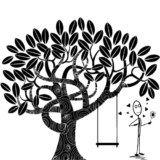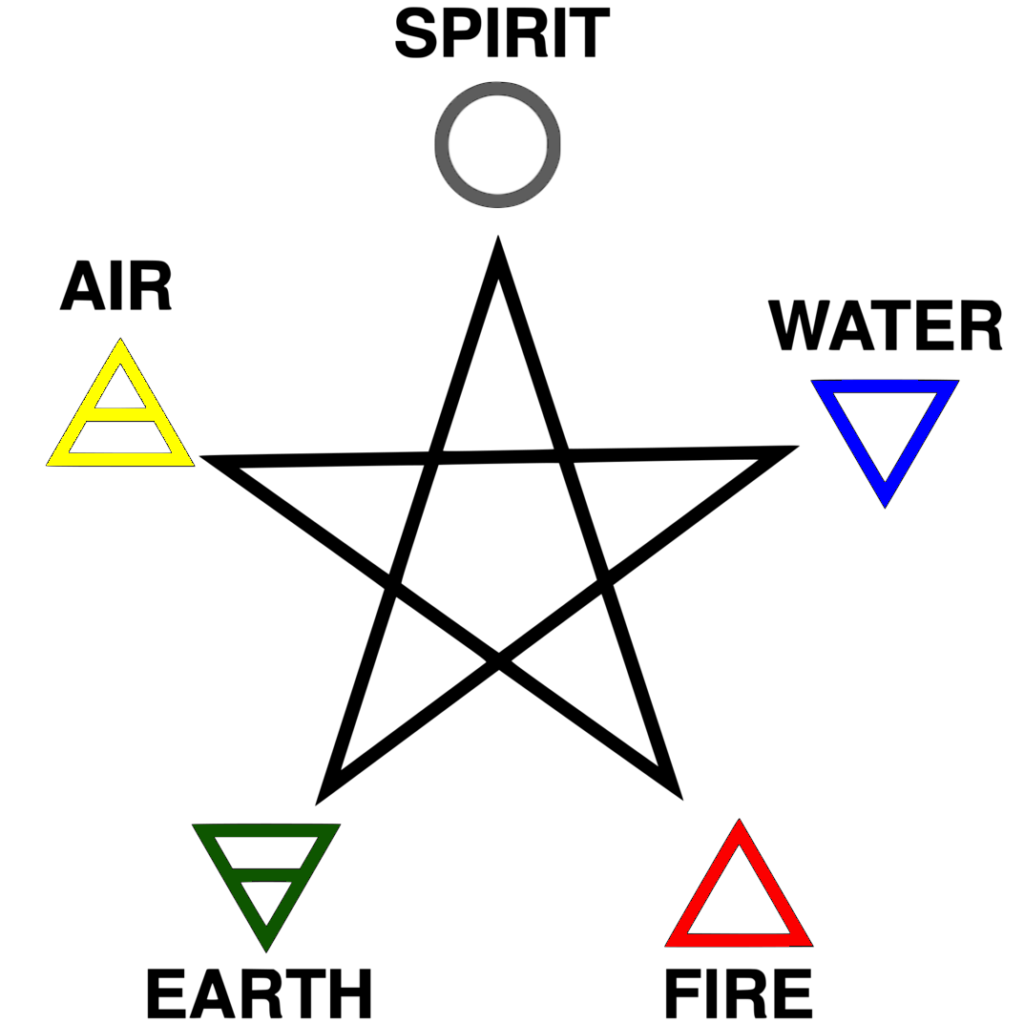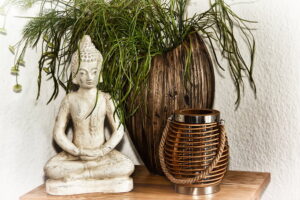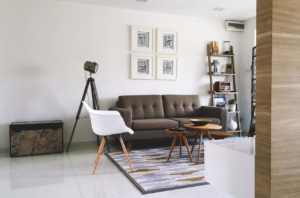In today’s fast-paced world, there’s nothing quite like the feeling of coming back to a home that exudes tranquility, balance, and positive energy. It’s your personal sanctuary, a space where the chaos of the outside world fades away, and where you can recharge your spirit. This is where Feng Shui, an ancient art that harnesses the energies of your surroundings, comes into play.
Welcome to this “Beginner’s Guide to Feng Shui for a Harmonious Home.” I’m here to take you on a journey through this fascinating practice, demystifying its principles, and showing you how to infuse your living spaces with a sense of harmony and positivity.
Think of it as a gentle makeover for your home—one that doesn’t involve major construction or a complete overhaul. Instead, it’s about making subtle, yet impactful changes that align your space with the natural ebb and flow of energy.
Picture this: You walk through your front door, and instantly, you feel lighter. Stress fades into the background, replaced by an undeniable sense of peace. Your living space radiates positivity, making every day a little brighter. That’s the magic of Feng Shui.
Throughout this guide, we’ll delve into practical techniques, from decluttering to understanding the power of colors, and from arranging furniture to incorporating the five elements. By the end of our journey together, you’ll have the know-how to embark on your own Feng Shui adventure, transforming your living spaces into havens of balance and harmony.
Whether you’re a complete newcomer to Feng Shui or have dabbled in it before, this guide is designed to meet you where you are. So, let’s embark on this journey together—a journey where positive energy, balance, and serenity are just around the corner. It’s time to unlock the potential of your living space and create a harmonious home that nurtures your well-being.
Understanding Feng Shui Basics
Understanding the basics of Feng Shui is like deciphering the language of your living space. It’s about recognizing the subtle yet profound energies that flow through every nook and cranny of your home. So, let’s dive into the foundational principles that will serve as your compass on this Feng Shui journey.
I. The Flow of Energy: Qi
At the heart of Feng Shui lies the concept of Qi (pronounced “chee”), which is the vital life force or energy that flows through everything. Think of it as the breath of your living space. Just as you feel invigorated after taking a deep breath, a well-energized space can uplift your spirits.
Qi flows in and around your home, affecting your physical and emotional well-being. My goal is to help you understand how to channel this energy to create a harmonious atmosphere.
II. Yin and Yang: The Balance of Opposites
Feng Shui teaches us about balance, symbolized by the ancient Chinese philosophy of Yin and Yang. Yin represents qualities like stillness, receptivity, and darkness, while Yang embodies activity, brightness, and movement. Achieving balance between these opposing forces is key to creating a harmonious environment.
Throughout this guide, I’ll show you how to recognize areas in your home where Yin or Yang energies dominate and how to bring them into balance.
III. The Bagua Map: Mapping Your Space
Imagine having a treasure map that reveals the hidden gems and potential pitfalls in your home. That’s precisely what the Bagua Map does in Feng Shui. It’s a grid that overlays your living space, helping you understand which areas correspond to different aspects of your life, such as wealth, relationships, and health.
I’ll guide you in using the Bagua Map to analyze your home, identifying areas that may require attention to enhance specific areas of your life. Understanding this map is like having a blueprint for optimizing your living space’s energy.
As we delve deeper into the world of Feng Shui, remember that it’s not about transforming your home overnight. Instead, it’s about making gradual, intentional changes that align your space with the flow of energy, fostering a sense of balance and harmony.
Decluttering and Organizing for Harmonious Energy
In the quest for a harmonious home through Feng Shui, the first step often involves clearing the physical and energetic clutter that accumulates in living spaces. When our environments are filled with excess, it can disrupt the natural flow of energy or Qi. So, let’s roll up our sleeves and begin this transformative process.
I. The Art of Decluttering
Clutter isn’t just about the accumulation of physical objects; it also symbolizes stagnant energy. To bring positive energy into your space, I recommend starting with one area at a time—perhaps your closet, kitchen, or workspace. As I’ve learned in my own journey with Feng Shui, decluttering can be a liberating experience. Letting go of items that no longer serve you creates space for new opportunities and refreshed energy.
II. The Magic of Tidying Up
Marie Kondo, a renowned organizing consultant, coined the term “spark joy” when decluttering. This philosophy aligns beautifully with Feng Shui. As you sift through your belongings, I encourage you to ask yourself, “Does this item spark joy? Does it contribute positively to my life?” If the answer is no, it might be time to let it go.
Remember that decluttering isn’t just about discarding; it’s also about organizing. Creating designated spaces for your belongings allows energy to flow freely.
III. Clearing Negative Energy
In addition to physical clutter, homes can accumulate negative or stagnant energy over time. This can result from arguments, stress, or simply the passage of time. Some techniques for energetically cleansing your space include smudging with sage or using sound healing methods.
The Five Elements in Feng Shui
In Feng Shui, the world is seen as a dynamic interplay of five fundamental elements: Wood, Fire, Earth, Metal, and Water. These elements are not just physical substances but also symbolic representations of various energies and qualities. By understanding how these elements interact, you can make intentional choices in your home’s decor and design to create a harmonious and balanced environment.
I. Wood (Symbolizing Growth and Vitality)
Wood represents the energy of growth, vitality, and expansion. It’s associated with qualities like flexibility and upward momentum. In Feng Shui, the Wood element is linked to the colors green and brown. To harness the energy of Wood, consider adding wooden furniture, plants, or decor with green and brown hues to areas of your home where you seek growth and fresh beginnings.
II. Fire (Symbolizing Passion and Transformation)
Fire symbolizes passion, transformation, and the energy of illumination. It’s associated with qualities like enthusiasm and brightness. In Feng Shui, the Fire element is represented by the colors red and orange. To invite the energy of Fire into your space, use these colors in your decor, consider candle placements, or incorporate lighting fixtures that emit warm and vibrant light.
III. Earth (Symbolizing Stability and Nurturing)
Earth represents stability, nurturing, and a sense of groundedness. It’s associated with qualities like reliability and support. In Feng Shui, the Earth element is linked to the colors beige and light yellow. To enhance the Earth energy in your home, opt for earthy tones in your decor and consider adding square or rectangular shapes to furniture or artwork.
IV. Metal (Symbolizing Clarity and Precision)
Metal symbolizes clarity, precision, and the energy of refinement. It’s associated with qualities like focus and orderliness. In Feng Shui, the Metal element is represented by the colors white and metallic shades. To harness the Metal energy, use these colors in your decor, incorporate metal accents or objects, and consider adding circular shapes to your space.
V. Water (Symbolizing Flow and Adaptability)
Water represents flow, adaptability, and the energy of renewal. It’s associated with qualities like intuition and relaxation. In Feng Shui, the Water element is linked to the colors blue and black. To invite the Water energy, incorporate these colors into your decor, consider adding mirrors, and introduce wavy or free-form shapes in your space.
Feng Shui Colors and Their Meanings
Colors have a profound impact on our mood, emotions, and energy. In Feng Shui, the choice of colors plays a significant role in creating the desired atmosphere in your home. Let’s explore the world of Feng Shui colors and understand their meanings.
I. The Power of Color in Feng Shui
Colors are like the paintbrushes of energy in your living space. Each hue carries its unique vibrational frequency, affecting the energy flow and ambiance. In Feng Shui, color choices are made based on their associations with the five elements and the Bagua areas.
II. Wood, Fire, Earth, Metal, and Water
Feng Shui categorizes colors into five elements, each corresponding to specific life areas and qualities. Here’s a brief overview:
- Wood: Greens and browns represent growth, vitality, and new beginnings.
- Fire: Reds, purples, and strong yellows symbolize passion, fame, and transformation.
- Earth: Light yellows, beige, and sandy colors relate to stability, nourishment, and relationships.
- Metal: Whites, grays, and metallic tones embody clarity, precision, and focus.
- Water: Blues and blacks evoke the energy of flow, mystery, and abundance.
III. Applying Feng Shui Colors
Understanding the elements and their corresponding colors allows you to select the right hues for different rooms and purposes in your home. For example, if you want to create a serene atmosphere in your bedroom, you might opt for soft blues or earthy browns.
I recommend you incorporate these colors into your living spaces, whether through wall paint, decor, or furnishings. With careful color choices, you can enhance the energy of each room and create a more harmonious environment.
IV. The Bagua Map and Color Associations
Remember the Bagua Map we discussed earlier? It also plays a role in color selection. Different areas of your home correspond to different life aspects. By integrating the appropriate colors in these areas, you can enhance specific areas of your life.
For instance, the wealth and prosperity area might benefit from the infusion of deep greens or purples, while the love and relationships area could be improved with warm, earthy tones.
As we delve further into the art of Feng Shui, keep in mind that your color choices should resonate with your personal preferences and the energy you want to cultivate in your space. The goal is to create an environment that feels uplifting and harmonious for you and your loved ones.
Arranging Furniture and Layout
Now that we’ve explored the core principles of Feng Shui, let’s turn our attention to the practical aspects of arranging furniture and designing your living spaces to optimize energy flow. The way you arrange your furniture can significantly impact the energy in your home, and I’m here to guide you through it.
I. The Power of Furniture Placement
The placement of furniture can either obstruct or enhance the flow of Qi in your space. It’s all about creating a welcoming and balanced environment. When arranging your furniture, consider the following:
- Command Position: For the most important pieces of furniture, like your bed or desk, place them in the “command position.” This means you have a clear view of the room’s entrance, symbolizing a sense of control and safety.
- Balance: Balance is a core principle in Feng Shui. Avoid clutter and ensure there’s a sense of symmetry in your room. It’s about creating equilibrium.
- Open Space: Keep pathways and walkways clear to allow Qi to flow freely. Avoid blocking windows and doors with furniture.
II. The Feng Shui Bedroom
The bedroom is a crucial space for rest and rejuvenation. Proper Feng Shui in the bedroom can lead to better sleep and improved overall well-being. Here’s how:
- Bed Placement: Position your bed so that you have a clear view of the bedroom door while lying in bed. This offers a sense of security and control.
- No Electronics: Keep electronic devices out of the bedroom to create a more peaceful atmosphere.
- Balance Elements: Use a balanced mix of elements (wood, fire, earth, metal, water) in your bedroom decor to create harmony.
III. The Art of Arrangement
Feng Shui also considers the positioning of decorative items and artwork. Each piece can carry its own energy, so choose them wisely.
- Mirrors: Mirrors are powerful in Feng Shui, as they can double the energy in a space. Use them strategically to expand positive energy.
- Plants: Indoor plants not only add beauty but also purify the air and promote positive energy flow.
- Artwork: Choose artwork that resonates with you and promotes feelings of joy and inspiration.
Incorporating these Feng Shui principles into your furniture arrangement and layout can have a profound impact on the energy and atmosphere of your home. It’s all about creating a space that nurtures and supports your well-being.
Enhancing Positive Energy
Now that you’ve grasped the fundamental concepts of Feng Shui, it’s time to explore how you can actively enhance the positive energy within your living spaces. Here in this section, I’ll share practical tips and techniques to infuse your home with harmonious vibrations.
I. Feng Shui Enhancements
Feng Shui enhancements are like little magic spells that can transform the energy in your home. Let’s have a look at some of these enhancements, such as:
- Plants: Discover the power of greenery to purify the air and revitalize your space.
- Crystals: Explore how crystals can be strategically placed to attract and amplify positive energy.
- Fountains: Learn how the soothing sound of flowing water can create a serene atmosphere.
- Mirrors: Understand the role of mirrors in Feng Shui and how to use them wisely for energy enhancement.
II. Symbolism and Intention
Feng Shui also places great importance on symbolism and intention. Here’s how:
- Use symbolism: Incorporate meaningful symbols, such as images of love or prosperity, to evoke the energy you desire.
- Set intentions: Harness the power of intention to infuse your living spaces with your goals and desires.
Whether it’s placing a vase of fresh flowers on your dining table or strategically positioning a mirror to expand a small room’s energy, these enhancements will empower you to create a more harmonious environment.
Feng Shui for Specific Rooms
Now, let’s dive into the heart of your home—each individual room. I’ll provide room-specific Feng Shui tips for key areas like the bedroom, living room, kitchen, and home office. By applying these insights, you can create customized harmonious spaces that cater to the unique energy needs of each room.
I. The Bedroom: Your Sanctuary of Rest
The bedroom is your personal sanctuary for rest and rejuvenation. To enhance its Feng Shui:
- Position the Bed Correctly: Place your bed so that it has a clear view of the bedroom door without being in direct line with it. This fosters a sense of security and control.
- Balance the Elements: Create a balanced atmosphere by incorporating all five elements. For instance, use wooden furniture, add earthy tones with decor, and place a pair of nightstands for symmetry.
- Minimize Electronics: Keep electronics to a minimum in the bedroom to reduce electromagnetic fields, allowing for a more peaceful sleep.
II. The Living Room: Gathering Energy and Harmony
The living room is where family and friends come together. To create a harmonious living space:
- Promote Conversation: Arrange seating to facilitate face-to-face conversation. A circular arrangement can promote inclusivity and open communication.
- Introduce Natural Elements: Bring nature indoors with plants and natural materials like wood and stone for a calming atmosphere.
- Declutter Mindfully: Keep the living room clutter-free, as clutter disrupts energy flow. Use storage solutions to maintain a tidy space.
III. The Kitchen: Nourishing Body and Soul
In Feng Shui, the kitchen is associated with nourishment and prosperity. To harness its positive energy:
- Keep It Clean: A clean kitchen promotes positive energy. Regularly clean countertops and appliances to maintain a hygienic and harmonious environment.
- Balance the Elements: Incorporate the five elements by adding metal (utensils), wood (cutting boards), and water (symbolized by a flowing tap).
- Avoid Sharp Corners: Round or soften sharp corners with plants or decor to create a more inviting and harmonious space.
IV. The Home Office: Productivity and Focus
With remote work becoming increasingly common, the home office plays a vital role. To optimize your home office Feng Shui:
- Choose the Right Location: Ideally, position your desk to have a clear view of the office door, providing a sense of control and security.
- Natural Light: Ensure ample natural light, which promotes energy and focus. If that’s not possible, use full-spectrum lighting.
- Declutter and Organize: A clutter-free workspace enhances concentration. Keep your desk tidy and organized, only displaying items that inspire and motivate.
By applying these room-specific Feng Shui tips, you can transform each area of your home into a harmonious and purposeful space that supports your well-being and goals. Remember, Feng Shui is not about strict rules but rather about creating spaces that resonate with you and your unique energy.
Conclusion
Congratulations! You’ve just embarked on a transformative journey into the world of Feng Shui—a journey that has the potential to bring balance, positivity, and harmony into your home and, by extension, into your life.
As we wrap up this beginner’s guide, I want to leave you with a few key takeaways:
- Feng Shui is a Language of Energy: Remember that Feng Shui is all about understanding the energies that flow through your living spaces. Just like a skilled conductor guides an orchestra to create beautiful music, you can learn to orchestrate the energy in your home to create a harmonious and positive environment.
- Start Small, Progress Gradually: Transforming your living space doesn’t require a massive overhaul. In fact, it’s often the small, intentional changes that make the most significant difference. Begin with one room or area, and gradually work your way through your home.
- Balance is the Key: Keep the principle of balance in mind. Feng Shui teaches us to find equilibrium between opposing forces, just as in the Yin and Yang symbol. Strive to achieve balance in your living spaces, as it can have a profound impact on your well-being.
- Intention Matters: The power of intention cannot be overstated in Feng Shui. When you make changes in your home, do so with a clear intention in mind. Whether it’s to invite more love into your life, boost creativity, or enhance tranquility, your intention will guide the energy.
- Continuous Learning: Feng Shui is a vast and intricate practice, and this guide is just the beginning. Consider exploring more advanced techniques, consulting with Feng Shui experts, or diving deeper into specific aspects that resonate with you.
Remember that the true essence of Feng Shui lies not only in creating a beautiful and harmonious living space but also in how it makes you feel. It’s about coming home to a place where stress melts away, where positivity thrives, and where you can be your most authentic self.
As you apply the principles and techniques you’ve learned in this guide, you’re taking significant steps toward transforming your home into a haven of balance and harmony. Your journey doesn’t end here; it’s an ongoing exploration that can bring you countless rewards in the form of improved well-being, enhanced relationships, and a deeper connection to your living space.
Thank you for joining me on this enlightening journey into the world of Feng Shui. May your home be a source of peace, joy, and positive energy for years to come.
With warmth and positive energy,
Rohit😊
Unlock the Magic of Feng Shui with Indoor Plants
Are you ready to take your indoor gardening journey to the next level? As you’ve explored the world of Feng Shui for harmonizing your living spaces, you’ve likely come to appreciate the profound impact of positive energy. Now, imagine channeling that energy through the vibrant, thriving greenery of indoor plants.
In my upcoming book, “Planting Indoors,” we’ll delve deeper into the magic of Feng Shui as it intertwines with the world of indoor plants. I’ll show you how to create a home that not only looks beautiful but also resonates with positive energy and holistic well-being.
Here’s a taste of what you can expect:
- Feng Shui for Indoor Plants: Discover the art of selecting and arranging indoor plants to optimize energy flow in your home. From the bedroom to the living room, we’ll explore the best plants for each space.
- Plant Care as a Spiritual Practice: Learn how nurturing your indoor garden can be a mindful and spiritually enriching experience. We’ll delve into the ancient wisdom that connects you with the essence of life.
- Creating Plant Harmony: Find out how to strike the perfect balance between your indoor plants and their surroundings. Feng Shui principles will guide you in arranging your green companions to maximize their positive impact.
If you’ve been intrigued by the idea of using indoor plants to enhance your living spaces and well-being, this book is your next step. It’s a journey of transformation, from simply having plants in your home to experiencing their full potential in fostering harmony and positive energy.
It is currently available for pre-order at a special discount. Don’t miss out on the chance to deepen your understanding of Feng Shui with indoor plants. Turn your home into a haven of balance, positivity, and vibrant green life.
Pre-order your copy today and unlock the magic of Feng Shui with indoor plants-
Transform your living spaces, transform your life!











